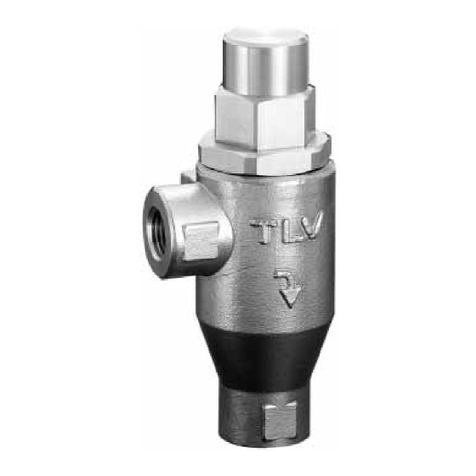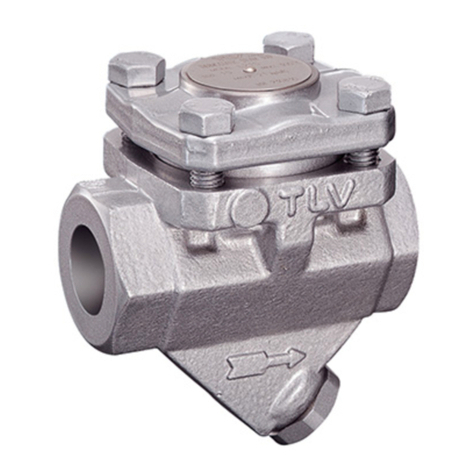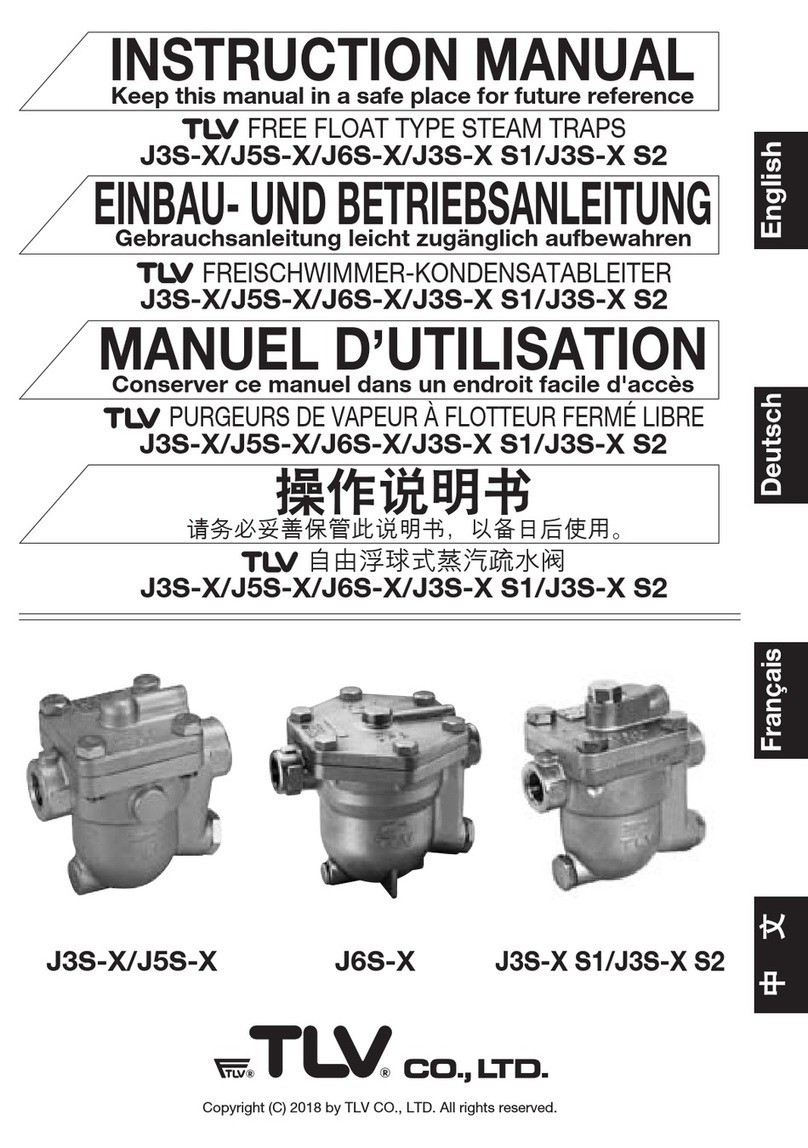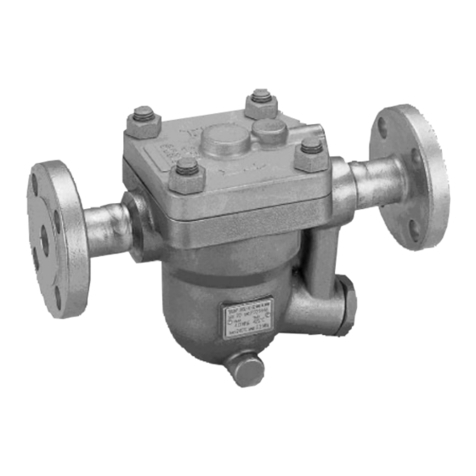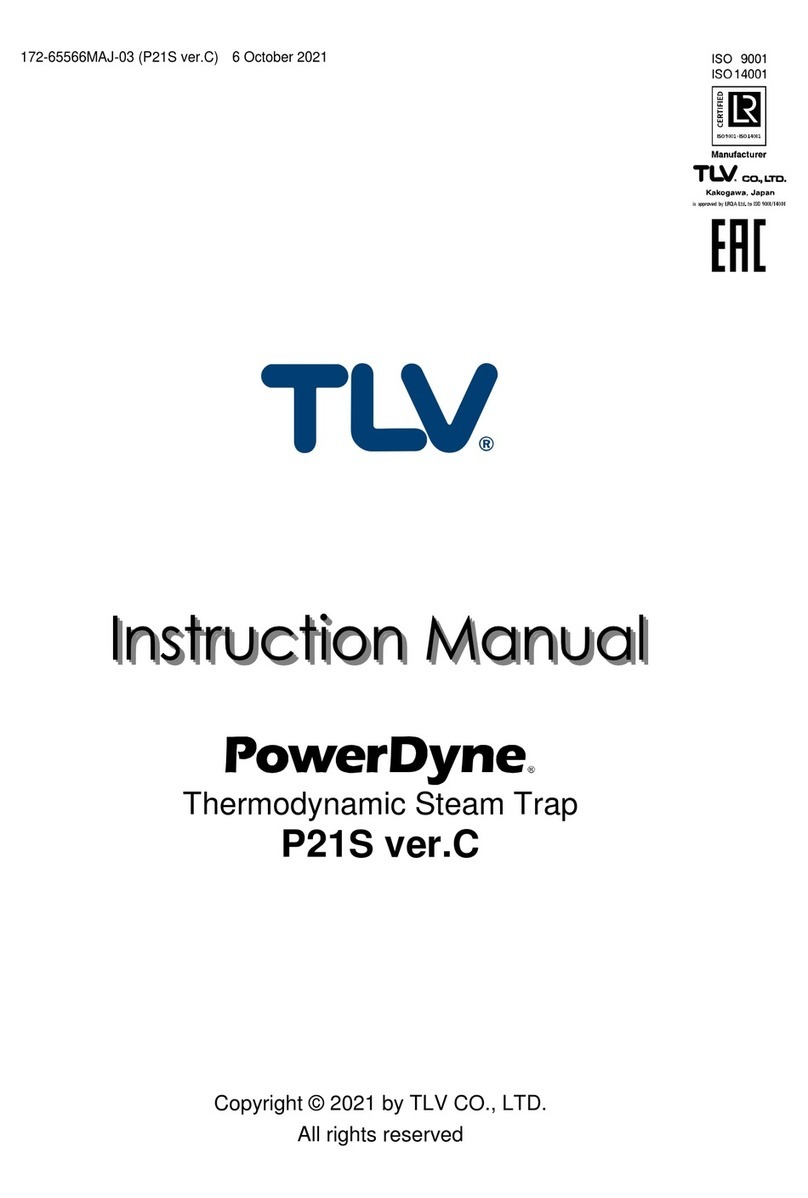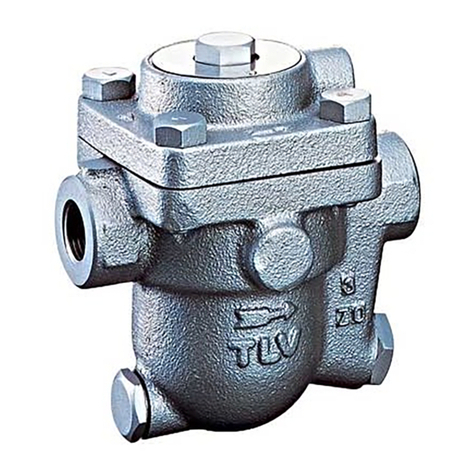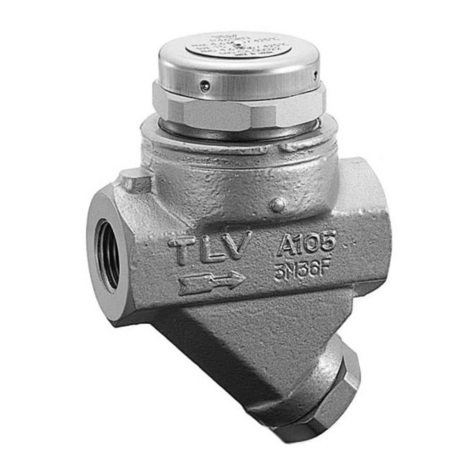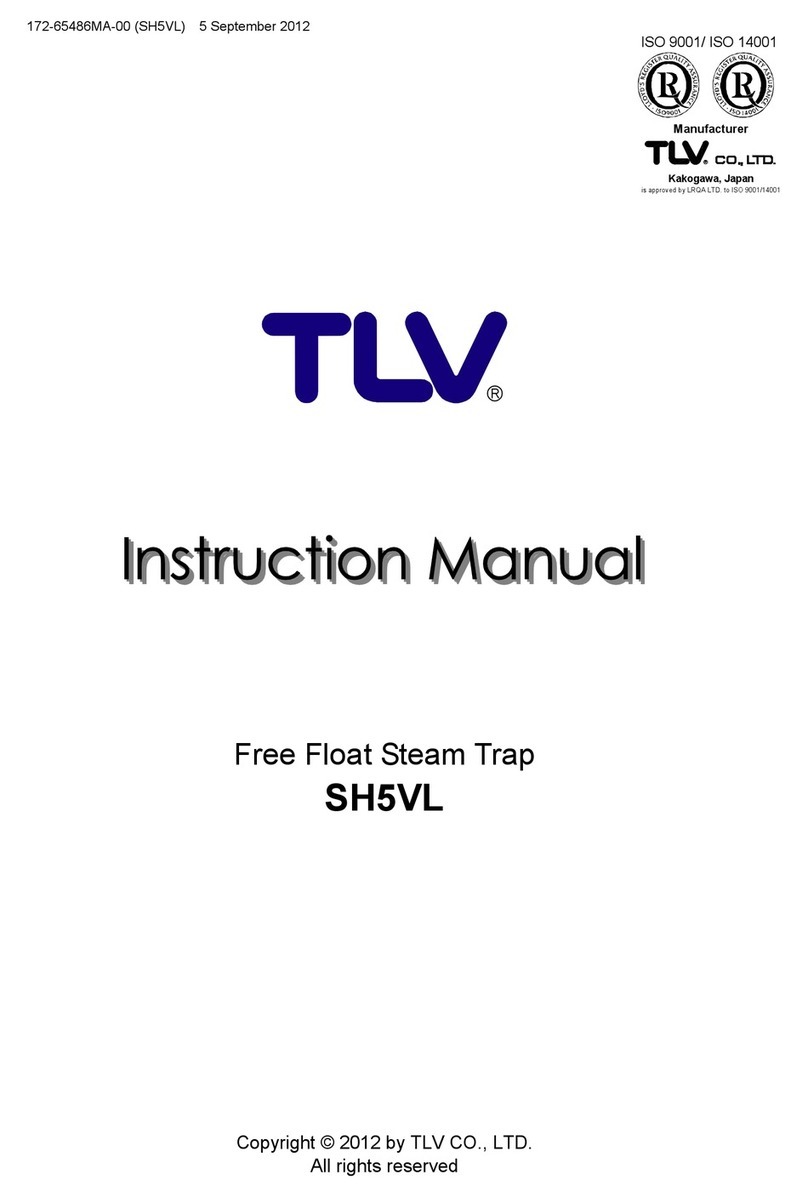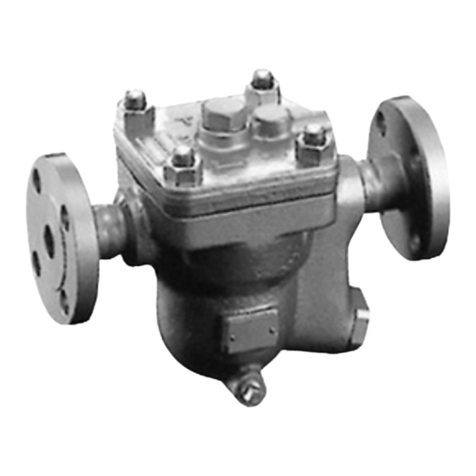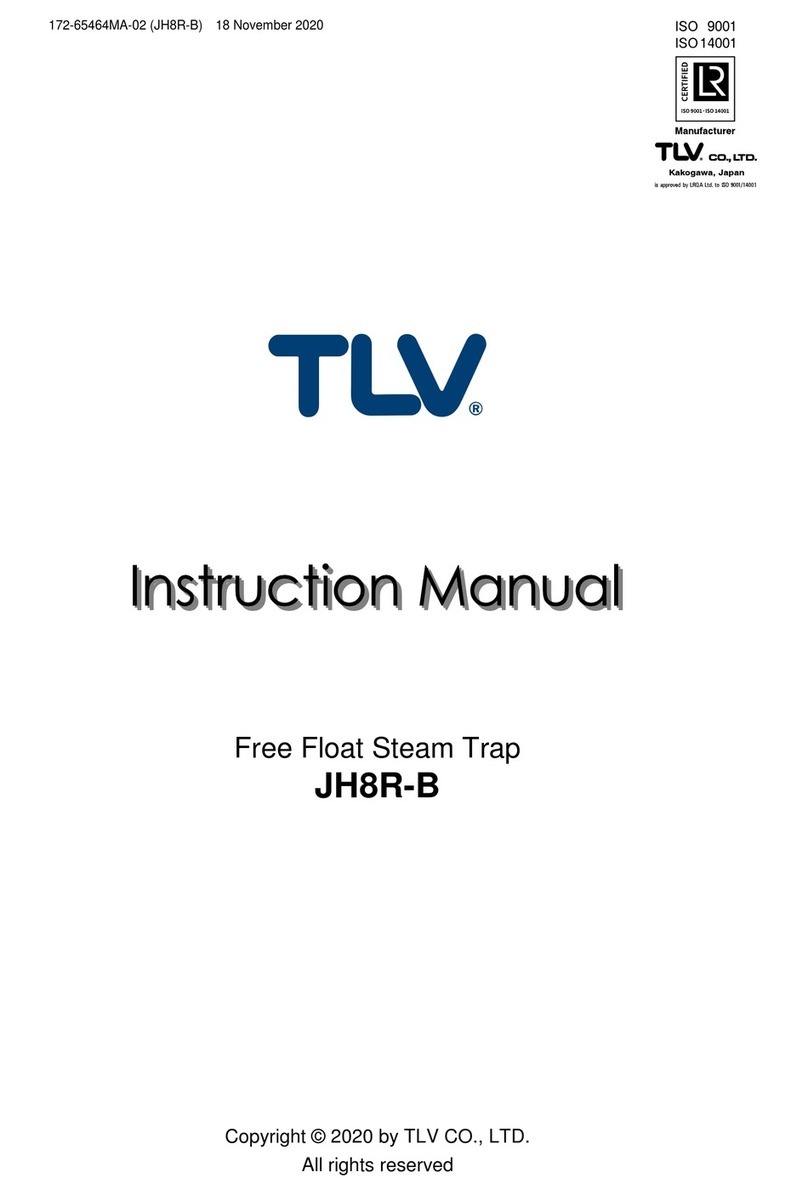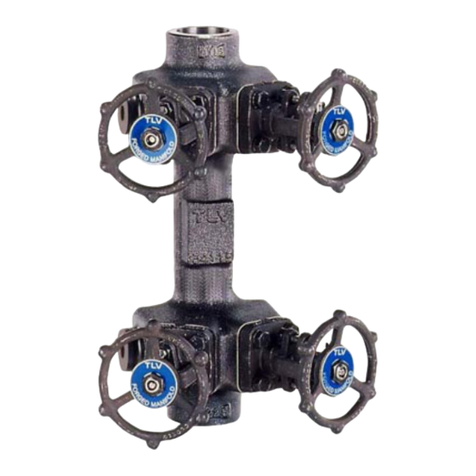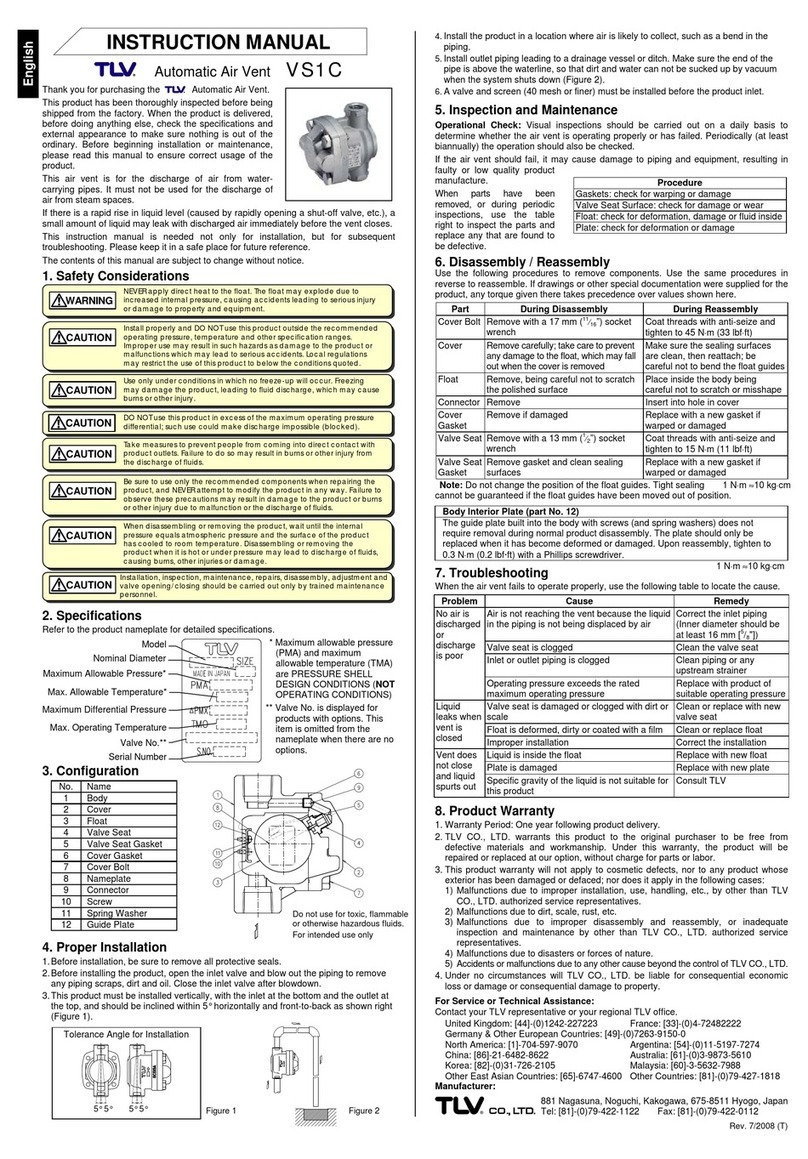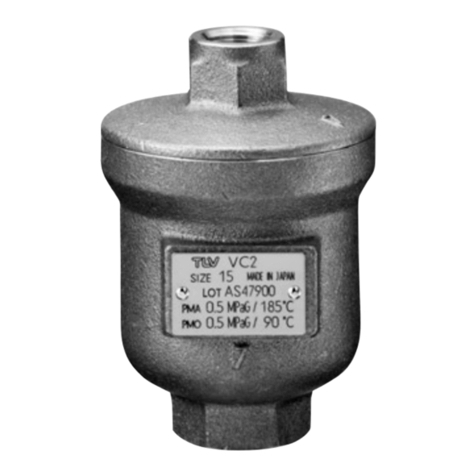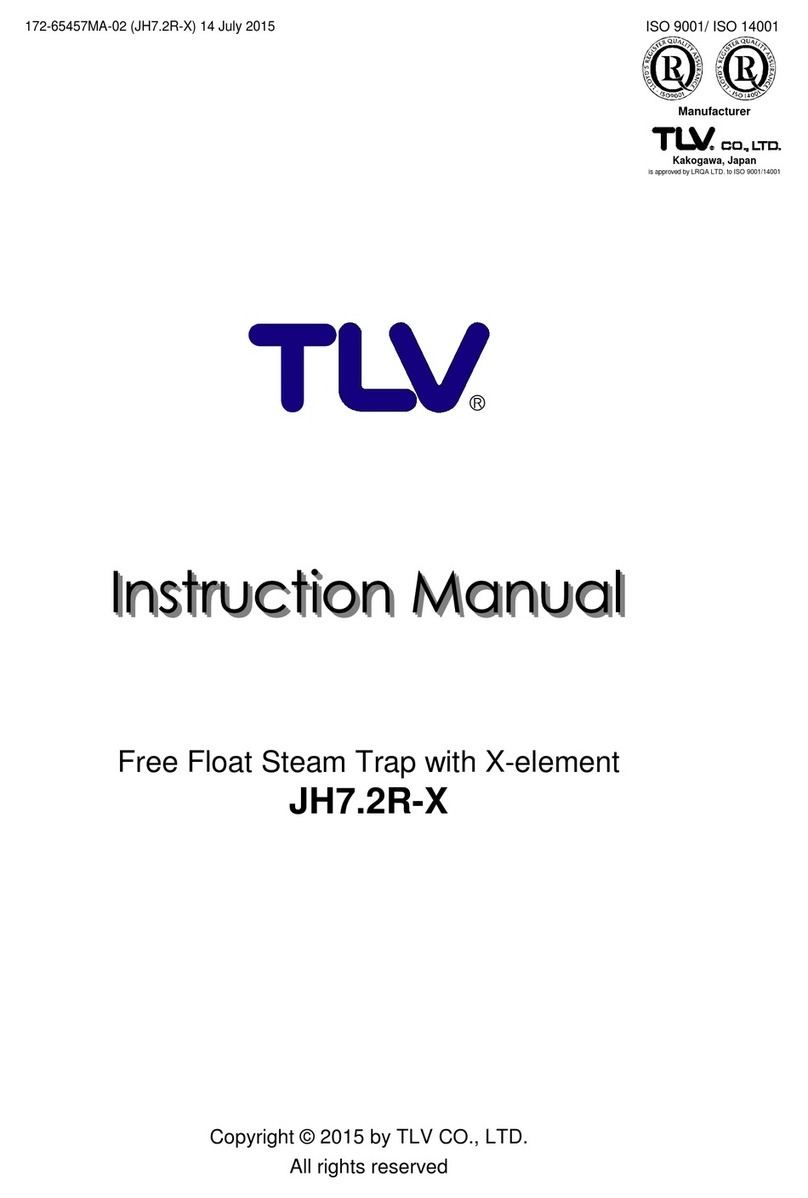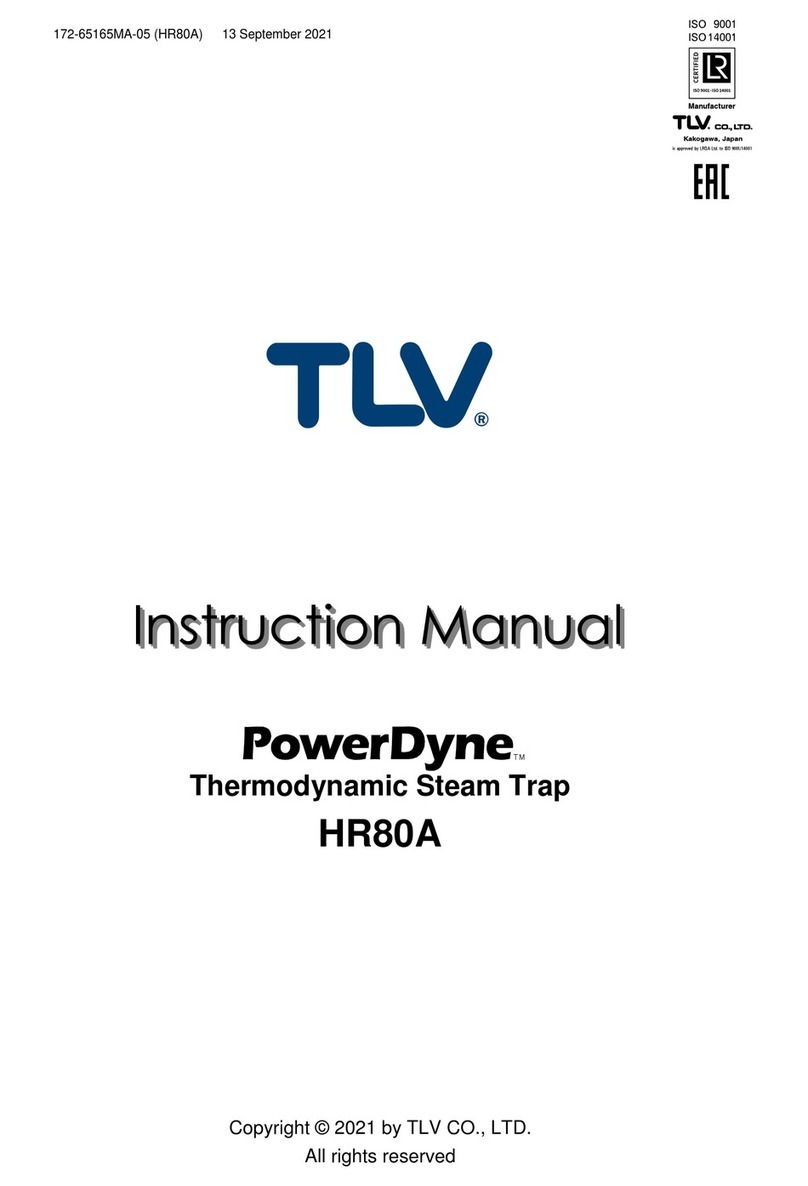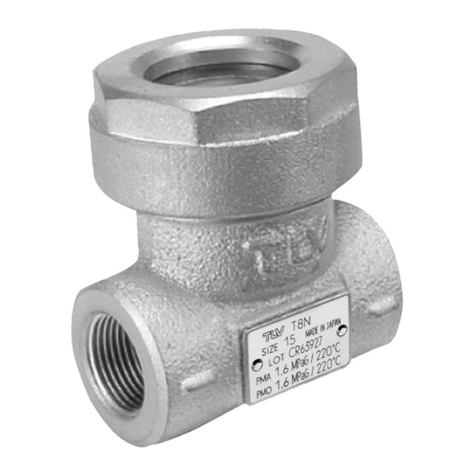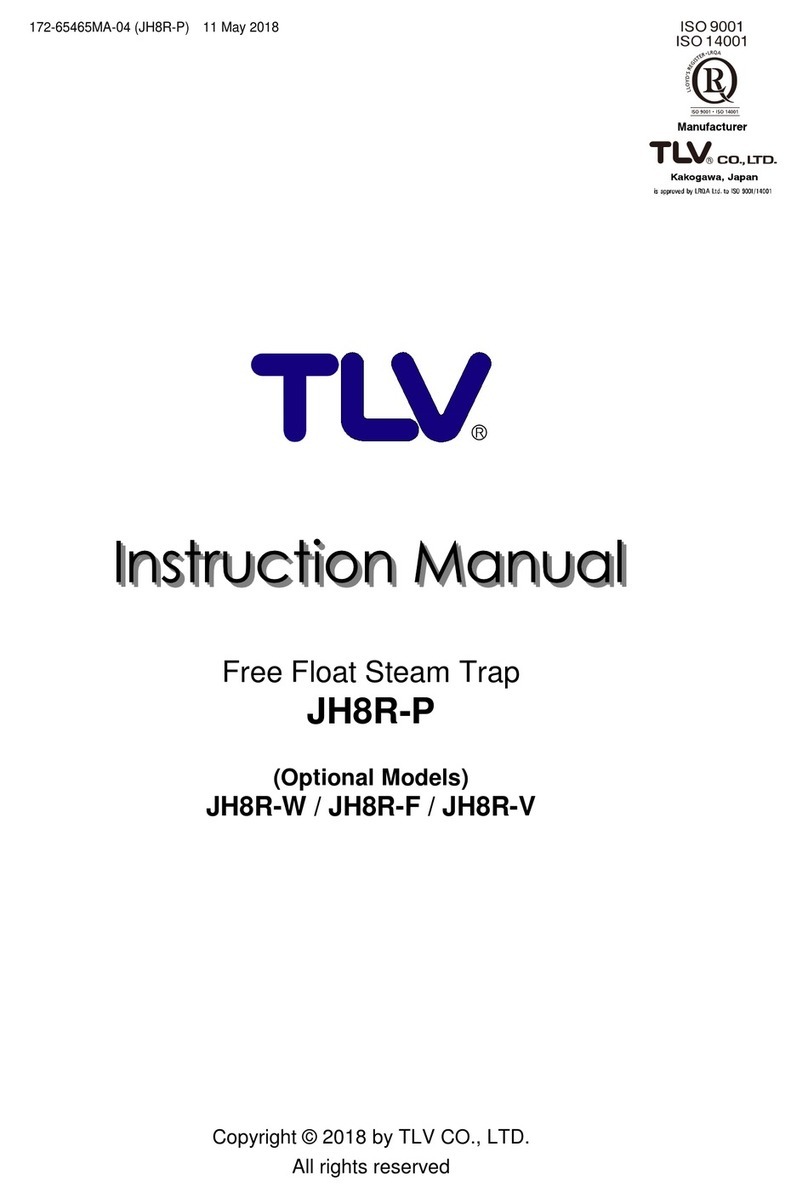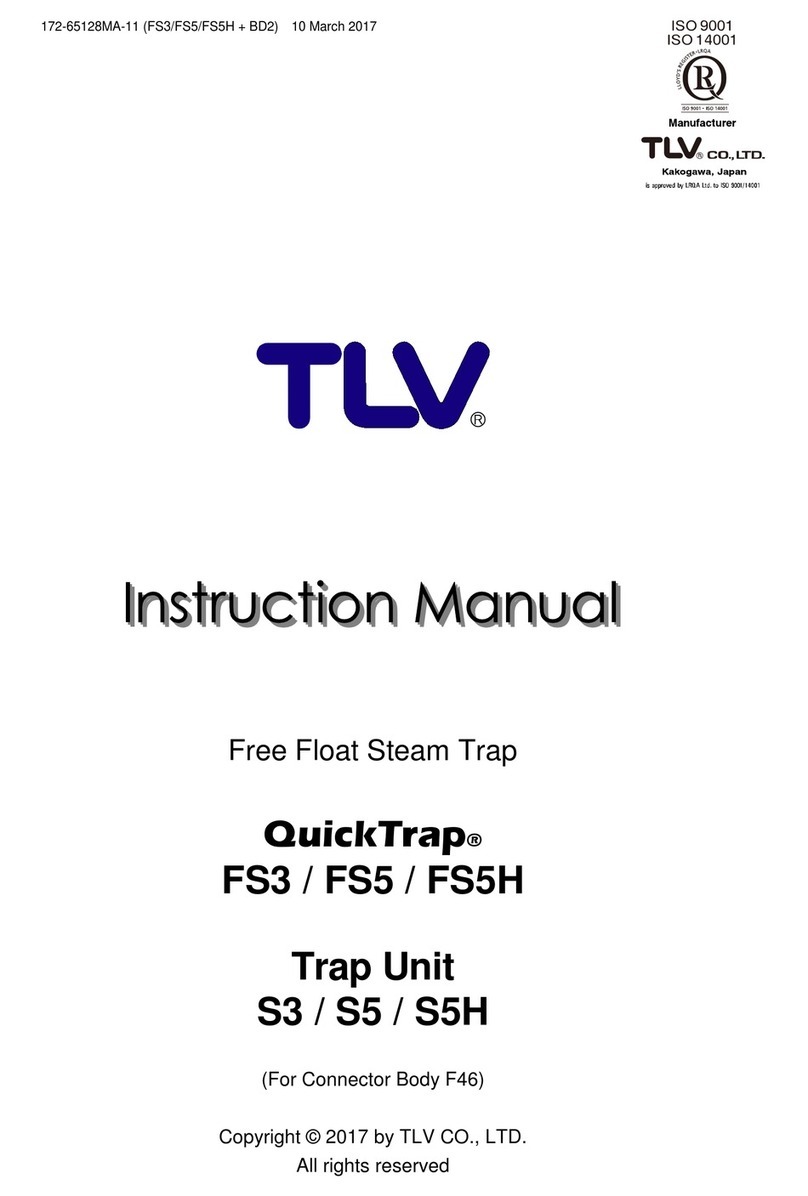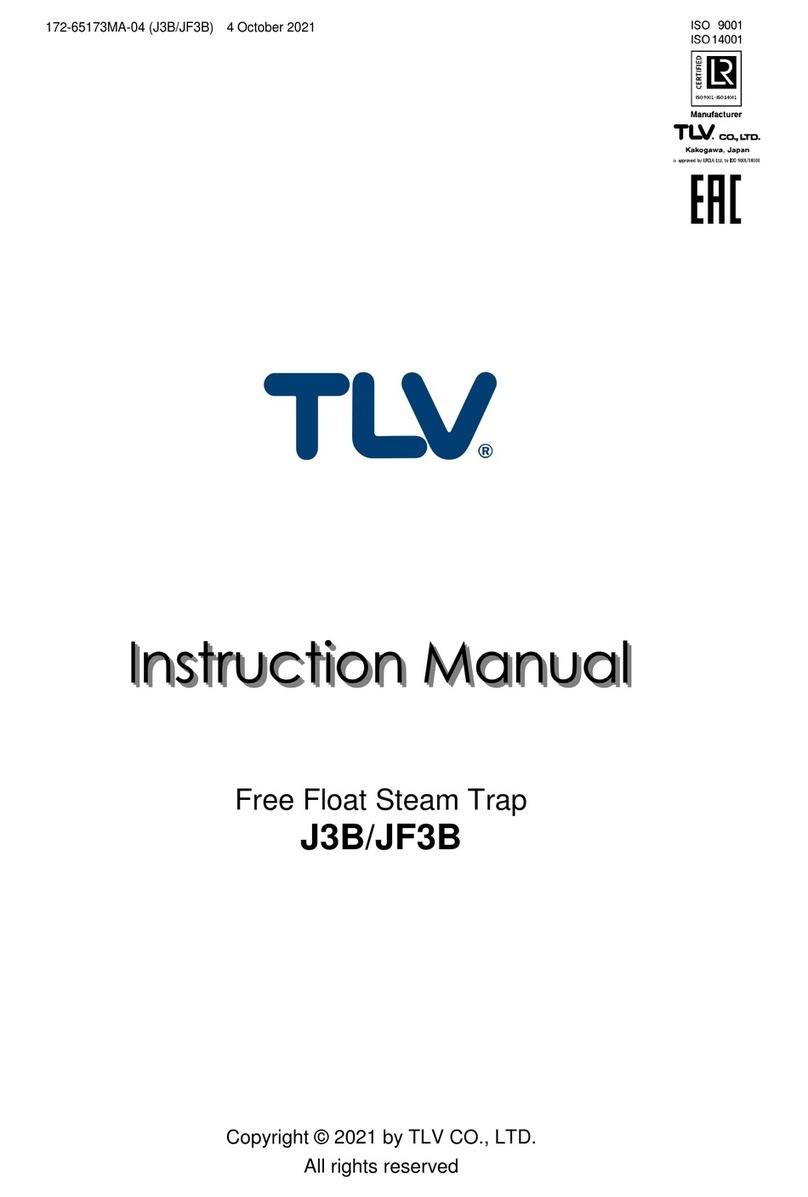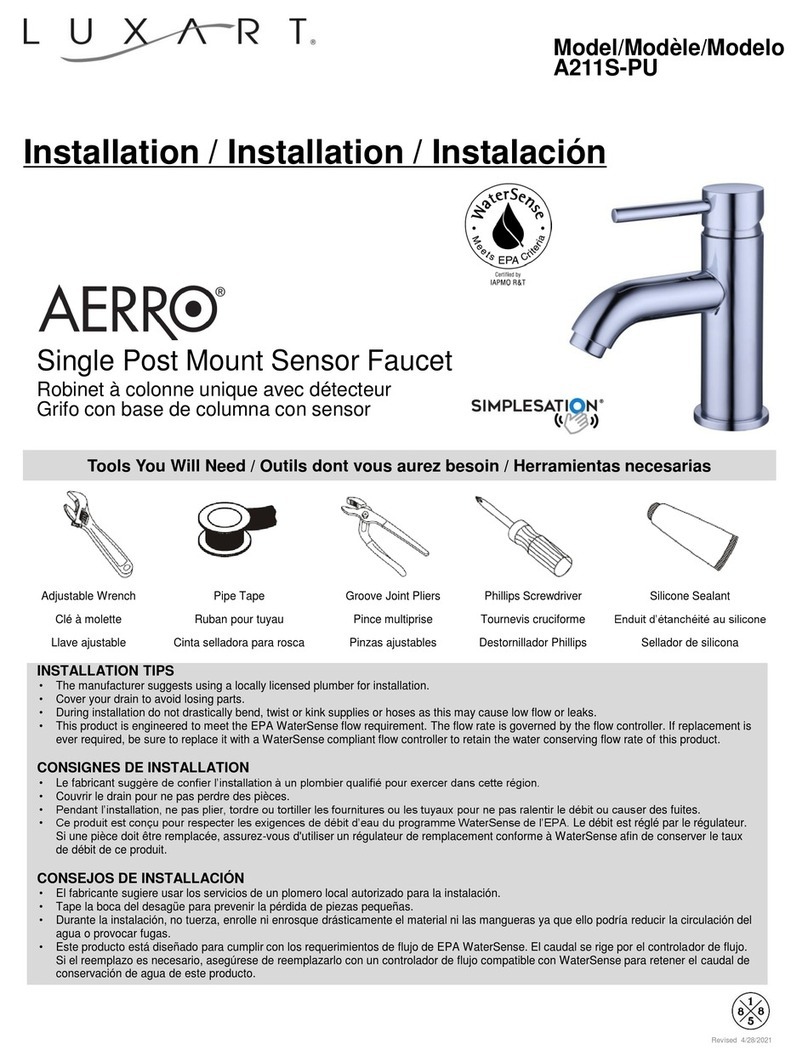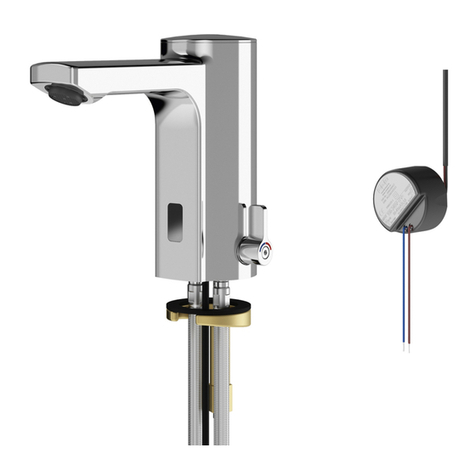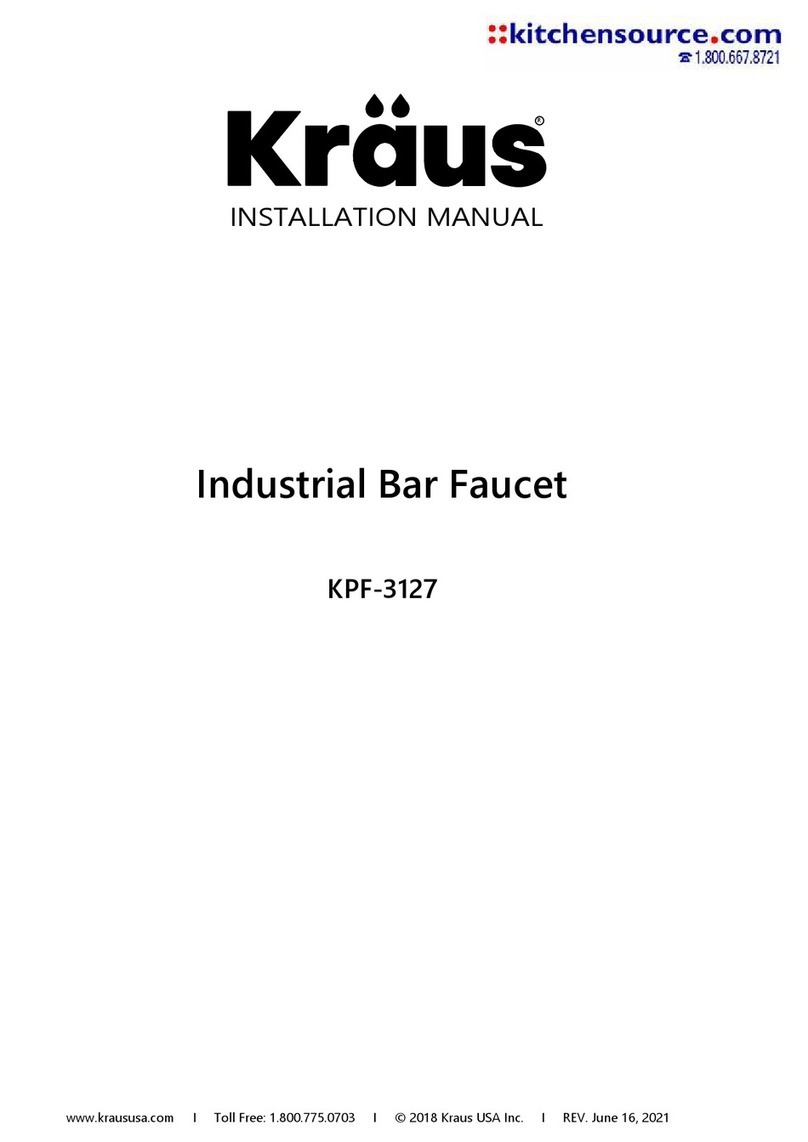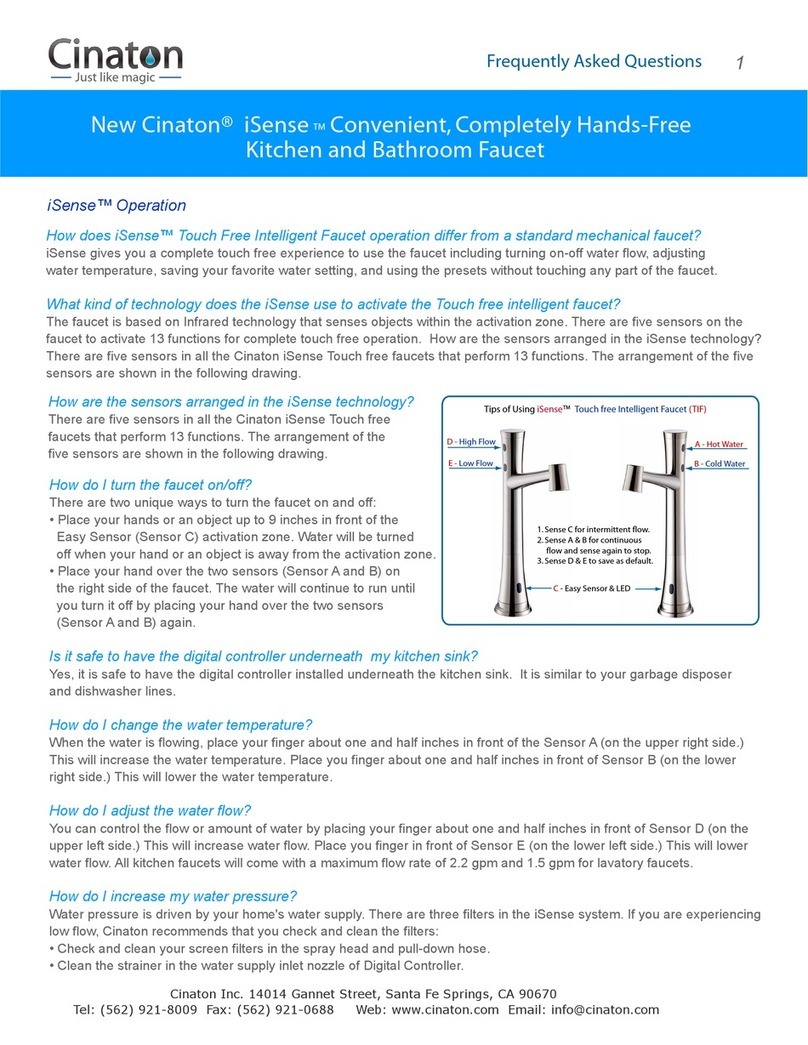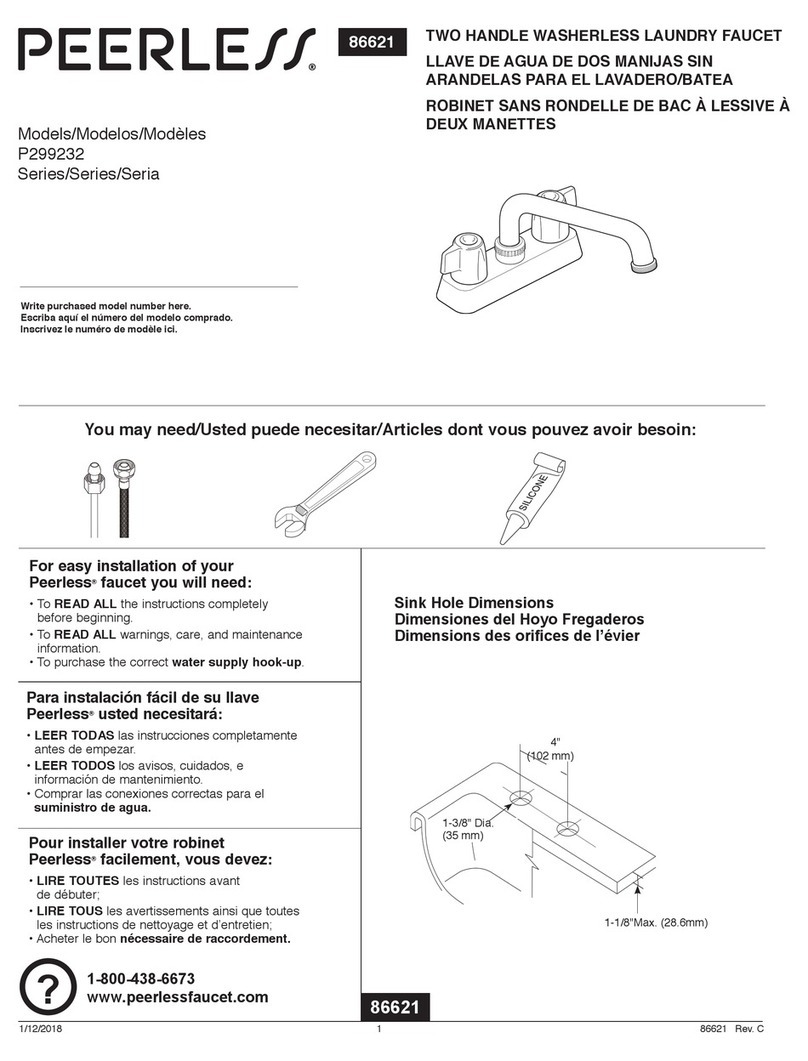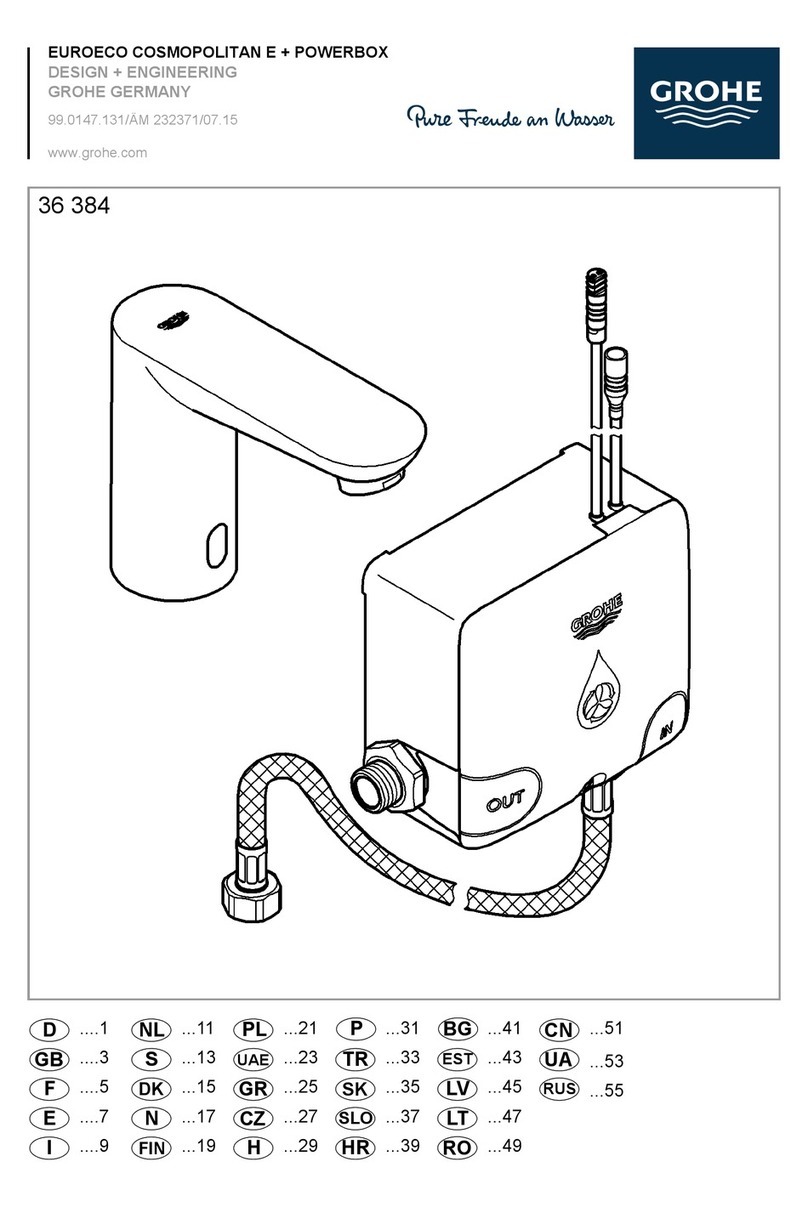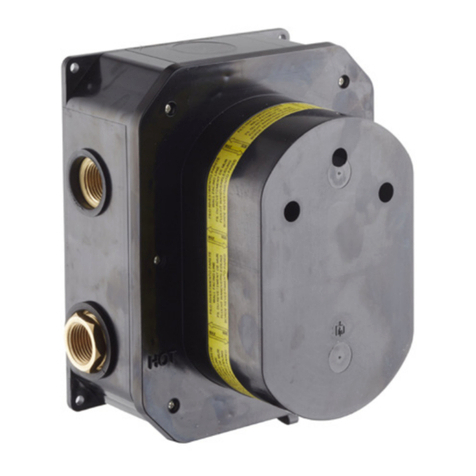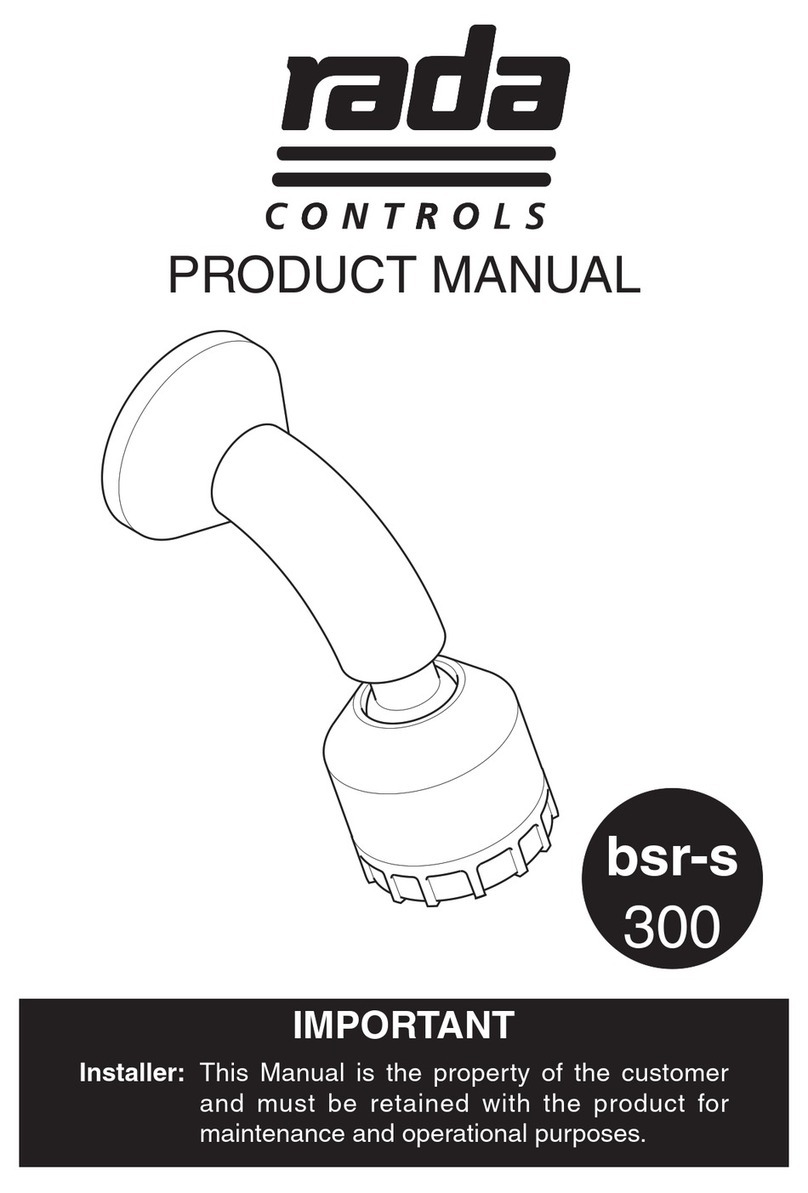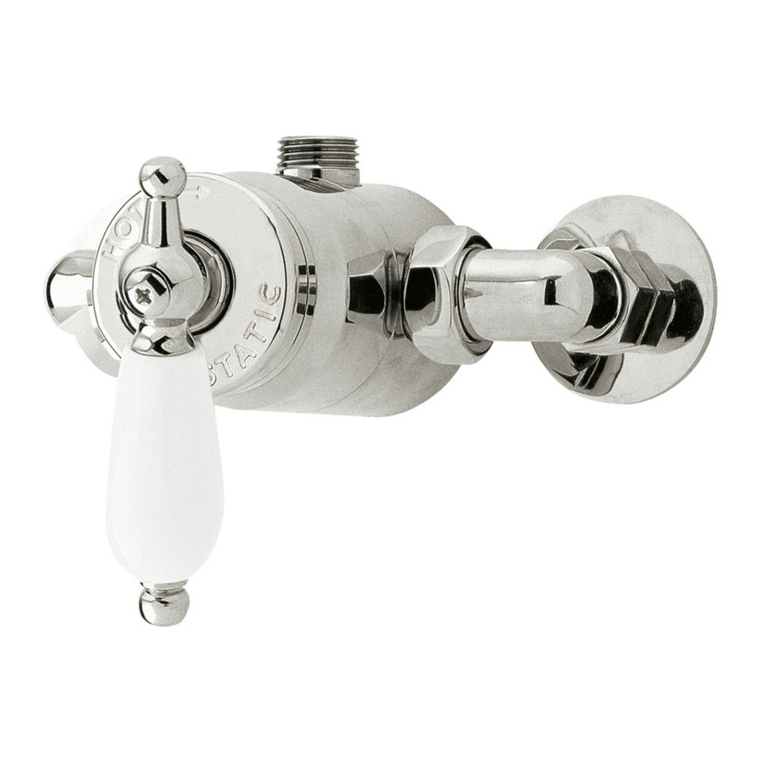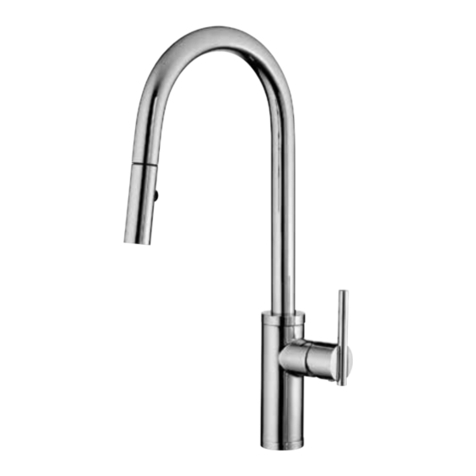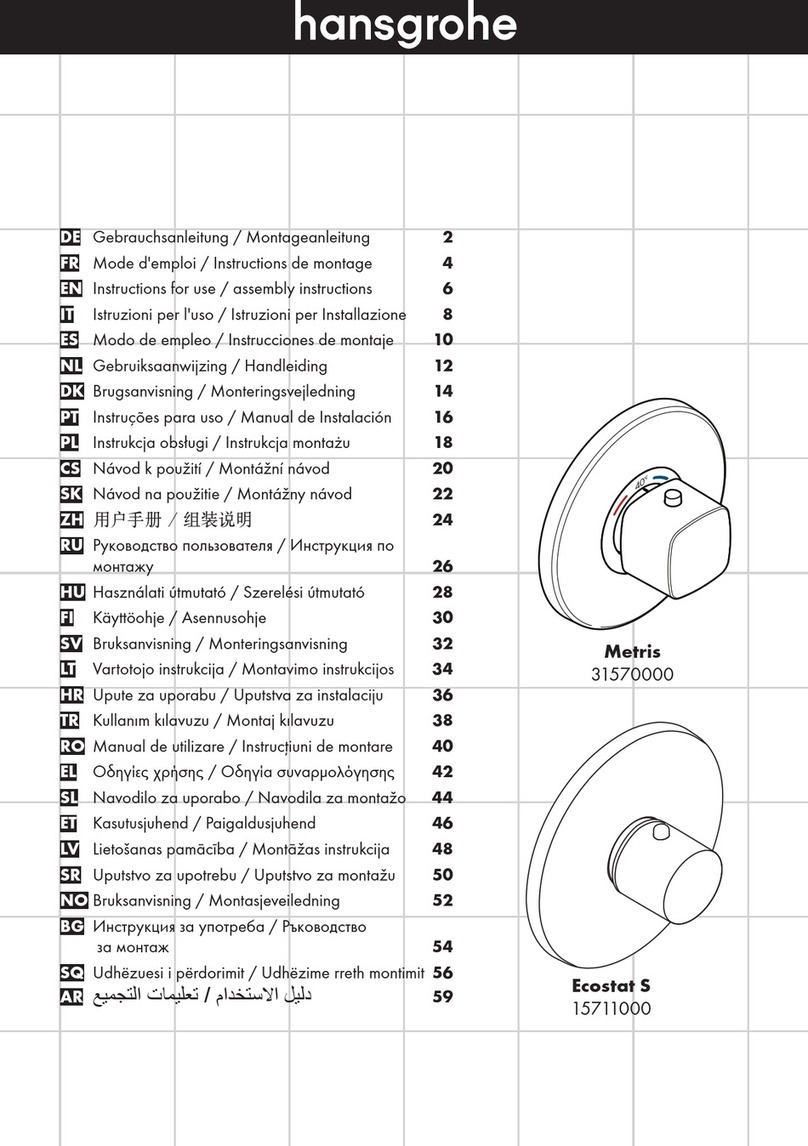TLV QuickTrap FL5 User manual

172-65126MA-10 (FL5/FL21/FL32/FL5-C/FL21-C/FL32-C + BD2) 10 March 2017
Thermostatic Steam Trap
QuickTrap®
FL5 / FL21 / FL32
FL5-C / FL21-C / FL32-C
Trap Unit
L5 / L21 / L32
L5-C / L21-C / L32-C
(For Connector Body F46)
Copyright © 2017 by TLV CO., LTD.
All rights reserved
Instruction Manual
Instruction Manual

172-65126MA-10 (FLl5/FL21/FL32/FL5-C/FL21-C/FL32-C + BD2) 10 Mar 2017
1
Contents
Introduction .............................................................................1
Checking the Piping................................................................4
Specifications..........................................................................5
Compatibility............................................................................6
Configuration...........................................................................6
Installation...............................................................................7
Maintenance............................................................................8
Disassembly / Reassembly.....................................................9
Instructions for Plug / Holder Disassembly and Reassembly12
Troubleshooting ....................................................................13
Product Warranty ..................................................................14
Options..................................................................................15
Introduction
Thank you for purchasing the thermostatic steam trap.
This product has been thoroughly inspected before being shipped from the factory. When
the product is delivered, before doing anything else, check the specifications and external
appearance to make sure nothing is out of the ordinary. Also be sure to read this manual
carefully before use and follow the instructions to be sure of using the product properly.
This steam trap is of a revolutionary design that uses a universal flange, and X-element
for the trap. The universal flange allows the trap to be installed in either horizontal or
vertical piping. This flexibility greatly reduces the time required for installation and
removal, as compared to conventional steam traps, and also facilitates repair and
maintenance operations.
This is a new type of valve mechanism in which a thermoliquid is sealed inside the X-
element and the valve opens or closes based on the difference between the saturation
temperatures of the thermoliquid and the water. The X-element is very sensitive to
changes in temperature, and responds with great accuracy, quickly discharging air and
the large quantities of condensate created immediately after operation start-up, thereby
greatly reducing start-up time. It also reacts with great sensitivity to the inflow of large
quantities of condensate and hot air during operation, preventing air binding.
The superior features of this steam trap’s X-element increase heating efficiency and
reduce manpower requirements for maintenance and bypass blowdown.
If detailed instructions for special order specifications or options not contained in this
manual are required, please contact for full details.
This instruction manual is intended for use with the model(s) listed on the front cover. It is
necessary not only for installation, but for subsequent maintenance,
disassembly/reassembly and troubleshooting. Please keep it in a safe place for future
reference.

172-65126MA-10 (FLl5/FL21/FL32/FL5-C/FL21-C/FL32-C + BD2) 10 Mar 2017
2
Safety Considerations
•Read this section carefully before use and be sure to follow the instructions.
•Installation, inspection, maintenance, repairs, disassembly, adjustment and
valve opening/closing should be carried out only by trained maintenance
personnel.
•The precautions listed in this manual are designed to ensure safety and
prevent equipment damage and personal injury. For situations that may occur
as a result of erroneous handling, three different types of cautionary items are
used to indicate the degree of urgency and the scale of potential damage and
danger: DANGER, WARNING and CAUTION.
•The three types of cautionary items above are very important for safety: be
sure to observe all of them as they relate to installation, use, maintenance and
repair. Furthermore, TLV accepts no responsibility for any accidents or
damage occurring as a result of failure to observe these precautions.
Symbols
Indicates a DANGER, WARNING or CAUTION item.
DANGER
Indicates an urgent situation which poses a threat of death or serious
injury
WARNING
Indicates that there is a potential threat of death or serious injury
CAUTION
Indicates that there is a possibility of injury or equipment / product
damage
CAUTION
Install properly and DO NOT use this product outside the
recommended operating pressure, temperature and other
specification ranges.
Improper use may result in such hazards as damage to the product
or malfunctions that may lead to serious accidents. Local regulations
may restrict the use of this product to below the conditions quoted.
Take measures to prevent people from coming into direct
contact with product outlets.
Failure to do so may result in burns or other injury from the
discharge of fluids.
When disassembling or removing the product, wait until the
internal pressure equals atmospheric pressure and the surface
of the product has cooled to room temperature.
Disassembling or removing the product when it is hot or under
pressure may lead to discharge of fluids, causing burns, other
injuries or damage.
Safety considerations continued on next page.

172-65126MA-10 (FLl5/FL21/FL32/FL5-C/FL21-C/FL32-C + BD2) 10 Mar 2017
3
CAUTION
Be sure to use only the recommended components when
repairing the product, and NEVER attempt to modify the product
in any way.
Failure to observe these precautions may result in damage to the
product and burns or other injury due to malfunction or the discharge
of fluids.
Use only under conditions in which no freeze-up will occur.
Freezing may damage the product, leading to fluid discharge, which
may cause burns or other injury.
The pressure and temperature values displayed on the
nameplate of the connector body are the values for the
connector body itself and not for the entire trap.
Improper use may result in such hazards as damage to the product or
malfunctions that may lead to serious accidents.
Use only under conditions in which no water hammer will occur.
The impact of water hammer may damage the product, leading to
fluid discharge, which may cause burns or other injury.

172-65126MA-10 (FLl5/FL21/FL32/FL5-C/FL21-C/FL32-C + BD2) 10 Mar 2017
4
Checking the Piping
Use only under conditions in which no water hammer will occur. The
impact of water hammer may damage the product, leading to fluid
discharge, which may cause burns or other injury.
CAUTION
Check to make sure that the pipes to be connected to the trap have been installed
properly.
1. Is the pipe diameter suitable?
2. Has sufficient space been secured for maintenance?
3. Have isolation valves been installed at the inlet and outlet? If the outlet is subject to
back pressure, has a check valve (TLV-CK) been installed?
4. Is the inlet pipe as short as possible, with as few bends as possible, and installed so
the liquid will flow naturally down into the trap?
5. Has the piping work been done correctly, as shown in the figures below?
Requirement
Correct
Incorrect
Install catchpot with the proper
diameter.
Diameter is too small.
Make sure the flow of
condensate is not obstructed.
Diameter is too small and inlet
protrudes into pipe interior.
To prevent rust and scale
from flowing into the trap, the
inlet pipe should be connected
25 – 50 mm (1 – 2 in) above
the base of the T-pipe.
Rust and scale flow into the
trap with the condensate.
When installing on the blind
end, make sure the flow of
condensate is not obstructed.
Condensate collects in the
pipe.

172-65126MA-10 (FLl5/FL21/FL32/FL5-C/FL21-C/FL32-C + BD2) 10 Mar 2017
5
Specifications
Install properly and DO NOT use this product outside the recommended
operating pressure, temperature and other specification ranges.
Improper use may result in such hazards as damage to the product or
malfunctions which may lead to serious accidents. Local regulations
may restrict the use of this product to below the conditions quoted.
CAUTION
Use only under conditions in which no freeze-up will occur. Freezing
may damage the product, leading to fluid discharge, which may cause
burns or other injury.
CAUTION
The pressure and temperature values displayed on the nameplate of the
connector body are the values for the connector body itself and not for
the entire trap. Improper use may result in such hazards as damage to
the product or malfunctions that may lead to serious accidents.
CAUTION
Refer to the product nameplates on the trap unit AND on the connector body for detailed
specifications.
The specifications displayed on each nameplate apply only to the unit on which it is
mounted. When a trap unit is installed on a connector unit and the PMA/TMA and/or
PMO/TMO values displayed on the two nameplates differ, the specifications for the
assembled products are restricted to the lower values.
Trap Unit
Production Lot No.
Valve No.**
Model
Maximum Allowable
Temperature (TMA)*
Nominal Diameter***
Maximum Operating
Temperature (TMO)
Maximum Allowable
Pressure*
Maximum Operating
Pressure
X-element Type
Connector Unit (mounted only on F46)
Model
Maximum Allowable
Temperature (TMA)*
Maximum Operating
Temperature (TMO)
Nominal Diameter
Maximum Allowable
Pressure*
Production Lot No.
Maximum Operating
Pressure
* Maximum allowable pressure (PMA) and maximum allowable temperature (TMA) are PRESSURE SHELL
DESIGN CONDITIONS, NOT OPERATING CONDITIONS.
** Valve No. is displayed for products with options. This item is omitted from the nameplate when there are
no options.
*** The nominal diameter is not printed on the trap unit nameplate when the trap unit is shipped by itself.
Maximum Operating Temperature
0.5
(75)
(482)
(464)
(392)
(302)
(212)
(455)
(437)
240 °C
235 °C
225 °C
250
220
200
150
100
1.0
(150)
1.5
(215)
2.1
(300)
2.5
(350)
3.0
3.2
(450)
0
FL32/FL32-C, L32/L32-C
FL21/FL21-C, L21/L21-C
FL5/FL5-C, L5/L5-C
Saturated Steam Curve
Operating Pressure MPaG (psig)
Temperature °C (°F)

172-65126MA-10 (FLl5/FL21/FL32/FL5-C/FL21-C/FL32-C + BD2) 10 Mar 2017
6
Compatibility
•The FL QuickTrap series employs a connector unit (F46) and is not compatible
with QuickTrap models using connector unit F46J.
•Trap unit (L5/L5-C/L21/L21-C/L32/L32-C) is compatible with Trap Stations
(V1/V2/V1P/V2P Series) and can be installed on those trap stations or connector unit
(F32).
The connector unit name is embossed on the connector body.
Configuration
*Option
Valve Seat with Check Valve
(“C” is added after the model name.)
No.
Name
M
R
T
C
No.
Name
M
R
T
C
1
Trap Body
11
Spring Clip
2
Connector Flange
12
Cover Bolt
3
Snap Ring
13
Trap Screen
4
Inner/Outer Connector
Gaskets
14
Connector Bolt
15
Connector Body
5
Valve Seat
16
Screen
6
Trap Cover
17
Screen Holder Gasket
7
Cover Gasket
18
Screen Holder
8
X-element
19
Connector Nameplate
9
X-element Guide
20
Flange
10
Nameplate
21
Check Valve Ball
M: Maintenance Kit
R: Repair Kit
T: Trap Unit (L5/L21/L32, L5-C/L21-C/L32-C)
C: Connector Unit (F46)
NOTE: Replacement parts for former connector body F32 differ from those for F46. When you
order replacement parts, please include the steam trap model name, size, connection type
and also the connector unit name.

172-65126MA-10 (FLl5/FL21/FL32/FL5-C/FL21-C/FL32-C + BD2) 10 Mar 2017
7
Installation
Install properly and DO NOT use this product outside the recommended
operating pressure, temperature and other specification ranges.
Improper use may result in such hazards as damage to the product or
malfunctions which may lead to serious accidents. Local regulations
may restrict the use of this product to below the conditions quoted.
CAUTION
Take measures to prevent people from coming into direct contact with
product outlets. Failure to do so may result in burns or other injury from
the discharge of fluids.
CAUTION
Installation, inspection, maintenance, repairs, disassembly, adjustment and valve
opening/closing should be carried out only by trained maintenance personnel.
1. Before installation, be sure to remove all protective seals.
2. Before installing the product, blow out the inlet piping to remove any piping scraps, dirt
and oil. Close the inlet valve after blowdown.
3. Install the product so the arrow on the body is pointing in the direction of condensate flow.
4. The connector body has no restrictions on installation orientation except for the
following conditions: the universal flange face (for connecting to the trap unit) must be
in the vertical plane, and the trap unit must be installed with the nameplate facing
upwards.
5. Install a condensate outlet valve and outlet piping.
6. Open the inlet and outlet valves and check to make sure that the product functions
properly.
If there is a problem, determine the cause using the “Troubleshooting” section in this
manual.
Installation Examples: Horizontal Piping
Correct
Incorrect
Nameplate is not facing upwards.
Universal Connector Flange is not
in the vertical plane.
Ground
Ground
Ground
Ground
Ground
Installation Examples: Vertical Piping
Correct
Incorrect
Nameplate is not facing upwards.
Ground
Ground
Ground
Nameplate
Connector
Flange
Connector
Flange
Nameplate

172-65126MA-10 (FLl5/FL21/FL32/FL5-C/FL21-C/FL32-C + BD2) 10 Mar 2017
8
Maintenance
Take measures to prevent people from coming into direct contact with
product outlets. Failure to do so may result in burns or other injury from
the discharge of fluids.
CAUTION
Be sure to use only the recommended components when repairing the
product, and NEVER attempt to modify the product in any way. Failure to
observe these precautions may result in damage to the product or burns
or other injury due to malfunction or the discharge of fluids.
CAUTION
Operational Check
A visual inspection of the following items should be done on a daily basis to determine
whether the trap is operating properly or has failed. Periodically (at least biannually) the
operation should also be checked by using diagnostic equipment such as a stethoscope,
thermometer, TLV Pocket TrapMan or TLV TrapMan.
If the trap should fail, it may cause damage to piping and equipment, resulting in faulty or
low quality products or losses due to steam leakage.
Normal
: Condensate is discharged continuously, together with flash steam,
and the sound of flow can be heard. If there is very little
condensate, there is almost no sound of flow.
Blocked
(Discharge Impossible)
: No condensate is discharged. The trap is quiet and makes no
noise, and the surface temperature of the trap is low.
Blowing
: Live steam continually flows from the outlet and there is a
continuous metallic sound.
Steam Leakage : Live steam is discharged through the trap outlet together with
condensate, accompanied by a high-pitched sound.
(When conducting a visual inspection, flash steam is sometimes mistaken for steam leakage. For
this reason, the use of a steam trap diagnostic instrument [such as TLV TrapMan if appropriate] in
conjunction with the visual inspection is highly recommended.)
Parts Inspection
When parts have been removed, or during periodic inspections, use the following table to
inspect the parts and replace any that are found to be defective.
Procedure
Gaskets:
Check for warping or scratches
Screens:
Check for clogging or corrosion
X-element:
Check for damage
Valve Seat:
Check for damage
Body Interior:
Valve Area on the
X-element, Valve Seat:
Check for build-up of scale
Check dirt, oil film, wear and damage
Clear, slightly
bluish jet
White jet
containing
water droplets
Flash Steam
Live Steam Leakage

172-65126MA-10 (FLl5/FL21/FL32/FL5-C/FL21-C/FL32-C + BD2) 10 Mar 2017
9
Disassembly/Reassembly
When disassembling or removing the product, wait until the internal
pressure equals atmospheric pressure and the surface of the product
has cooled to room temperature. Disassembling or removing the
product when it is hot or under pressure may lead to discharge of fluids,
causing burns, other injuries or damage.
CAUTION
Use the following procedures to remove components. Use the same procedures in
reverse to reassemble. (Installation, inspection, maintenance, repairs, disassembly,
adjustment and valve opening/closing should be carried out only by trained maintenance
personnel.)
Detaching/Reattaching the Trap Body and the Connector Body
Part
During Disassembly
During Reassembly
Connector Bolts
Remove with a socket wrench
Consult the table of tightening torques
and tighten to the proper torque
Trap Unit
Remove the trap unit
Follow the special instructions below
(See Fig.A)
Connector
Gaskets
Remove with a scraper and clean the
connector flange with a soft tool.
Replace with new gaskets; to facilitate
assembly and prevent loosening of the
gaskets, apply a small amount of
adhesive at 120º intervals around the
outer edge of the gaskets
Attaching the Trap Unit to the Connector Body
1.
If attaching a new trap unit, be sure to remove the protective
cap from the connector flange. Be careful not to drop the
gaskets when removing the cap.
2.
Grasp the end of the trap unit and align its gasket housing
with the indentation on the connector body. Be sure to have
the nameplate facing upwards.
3.
Once aligned, insert and finger tighten the connector bolts.
Verify that the trap unit is within the allowable inclination.
Figure A
Disassembly/Reassembly of Components Inside the Connector Body
Part
During Disassembly
During Reassembly
Screen Holder
Remove with a socket wrench
Consult the table of tightening torques
and tighten to the proper torque
Screen Holder
Gasket
Remove the gasket
Replace with a new gasket only if
warped or damaged
Screen
Remove with needle-nose pliers
Insert securely into the connector body

172-65126MA-10 (FLl5/FL21/FL32/FL5-C/FL21-C/FL32-C + BD2) 10 Mar 2017
10
Removing/Reassembling the Components Inside the Body
Part
During Disassembly
During Reassembly
Cover Bolt
Remove with a socket wrench
Consult the table of tightening
torques and tighten to the
proper torque
Trap Cover
Lift straight up and out.
Remove without scratching
the surface.
Make sure there are no
pieces of the old gasket left
on the sealing surfaces and
then reattach
Spring Clip
Remove with needle-nose
pliers
Insert securely into the slot in
the X-element guide (Figure A)
X-element
Grasp the ball on the top of
the X-element with pliers and
remove
Make sure the side of the X-
element with the ball on it is
facing up and insert, keeping
the X-element level and
making sure it does not catch
on the guide (Figure B)
Valve Seat
Remove with a socket wrench
Consult the table of tightening
torques and tighten to the
proper torque
X-element Guide
Remove without bending
Fix with Valve Seat and make
sure the X-element can be
inserted smoothly
Trap Screen
Remove without bending
Insert without bending
Cover Gasket
Remove with a scraper
without scratching the seating
surface of the trap body.
Replace with a new gasket.
Make sure there are no
pieces of the old gasket left
on the sealing surfaces of
the body and then reattach
Table of Tightening Torques
Part Name
Torque
Distance Across Flats
N⋅m
(lbf·ft)
mm
(in)
Valve Seat
35
(26)
19
(3/4)
Connector Bolt
39
(28)
14
(9/16)
Cover Bolt
35
(26)
13
(1/2)
Screen Holder (when F46 is used)
100
(73)
30
(13/16)
Flanged
15 – 25 mm (1/2– 1 in)
60
(44)
22
(7/8)
Screen
Holder
(when F32
is used)
Screwed
15, 20 mm (1/2, 3/4in)
60
(44)
22
(7/8)
25 mm (1 in)
150
(110)
38
(11/2)
Socket
Welded
15, 20 mm (1/2, 3/4in)
60
(44)
22
(7/8)
25 mm (1 in)
150
(110)
38
(11/2)
NOTE:
-Coat all threaded portions with anti-seize.
-If drawings or other special documentation were supplied for the
product, any torque given there takes precedence over values shown
here.
(1 N⋅m ≈10 kg⋅cm)
Screen Holders for Connector Units F32 and F46 can be used only with their respective connector
body.
When disassembling and reassembling the components, make sure that the correct connector unit
(F32 or F46) is used. The type of connector unit can be identified by the name embossed on its
body.
Figure B

172-65126MA-10 (FLl5/FL21/FL32/FL5-C/FL21-C/FL32-C + BD2) 10 Mar 2017
11
Exploded View
(T) Trap Unit
(C) Connector Unit
Cover Bolt (T)
Trap Cover (T)
Spring Clip (T)
X-element (T)
Valve Seat (T)
X-element
Guide (T)
Trap Screen (T)
Cover Gasket (T)
Trap Body (T)
Inner/Outer Connector
Gaskets (T)
Screen (C)
Connector Body (C)
Screen Holder Gasket (C)
Screen Holder (C)
Connector Bolt (T)
Connector Flange (T)
Nameplate (T)
Connector
Nameplate (C)

172-65126MA-10 (FLl5/FL21/FL32/FL5-C/FL21-C/FL32-C + BD2) 10 Mar 2017
12
3
5
6
Gasket
Do not pinch gasket
in thread recesses
4
Coat with anti-seize
Gasket Surface
Instructions for Plug/Holder Disassembly and Reassembly
The seal on the threaded plugs/holders found on TLV products is formed by a flat metal
gasket. There are various installation orientations for the gaskets, such as horizontal,
diagonal and downward, and the gasket may be pinched in the thread recesses during
assembly.
Instructions for Disassembly and Reassembly
①Remove the plug/holder using a tool of
the specified size (distance across flats).
②The gasket should not be reused. Be
sure to replace it with a new gasket.
③Clean the gasket surfaces of the
plug/holder and the product body using a
rag and/or cleaning agents, then check to
make sure the surfaces are not scratched
or deformed.
④Coat both the gasket surface of the
plug/holder and the threads of the
plug/holder with anti-seize, then press
the gasket onto the center of the gasket
surface of the plug/holder, making sure
the anti-seize affixes the gasket tightly to
the plug/holder. Check to make sure the
gasket is not caught in the recesses of
the threads.
⑤Hold the plug/holder upside down to
make sure that the anti-seize makes the
gasket stick to the plug/holder even
when the plug/holder is held upside
down.
⑥Screw the plug/holder by hand into the product body while making sure that the
gasket remains tightly affixed to the center of the gasket surface of the plug/holder.
Make sure the entire gasket is making contact with the gasket surface of the product
body. It is important at this point to make sure the gasket is not pinched in the thread
recesses of the plug/holder.
⑦Tighten the plug/holder to the proper torque.
⑧Next, begin the supply of steam and check to make sure there is no leakage from the
part just tightened. If there is leakage, immediately close the inlet valve and, if there
is a bypass valve, take the necessary steps to release any residual pressure. After
the surface of the product cools to room temperature, repeat the procedure
beginning from step 1.

172-65126MA-10 (FLl5/FL21/FL32/FL5-C/FL21-C/FL32-C + BD2) 10 Mar 2017
13
Troubleshooting
When disassembling or removing the product, wait until the internal
pressure equals atmospheric pressure and the surface of the product
has cooled to room temperature. Disassembling or removing the
product when it is hot or under pressure may lead to discharge of fluids,
causing burns, other injuries or damage.
CAUTION
If the product fails to operate properly, use the following table to locate the cause and
remedy.
Problem
Cause
Remedy
No condensate is
discharged (blocked)
or discharge is poor
The X-element is sticking to the
valve seat
Clean parts
The screen is clogged
Clean parts
The trap operating pressure exceeds
the maximum specified pressure or
there is insufficient pressure
differential between the trap inlet and
outlet
Compare specifications and actual
operating conditions
Steam is discharged
or leaks from the
outlet
(blowing)
(steam leakage)
There is rust or scale between the
valve area on the X-element and the
valve seat
Clean parts
The X-element valve and valve seat
are damaged
Replace with a new X-element
and/or valve seat
The X-element is broken
Replace with a new X-element
The installation is incorrect
Correct the installation
There is vibration of the trap
Lengthen the inlet piping and fasten
it securely
Steam is leaking from
a place other than the
outlet
Gasket deterioration or damage
Replace with a new gasket
Improper tightening torques were
used
Tighten to the proper torque
NOTE: If parts need replacement, refer to the parts list in this manual and select the appropriate
kit/unit for replacement parts. Parts are only available as a part of the kits/units shown.

172-65126MA-10 (FLl5/FL21/FL32/FL5-C/FL21-C/FL32-C + BD2) 10 Mar 2017
14
Product Warranty
1. Warranty Period
One year following product delivery.
2. Warranty Coverage
TLV CO., LTD. warrants this product to the original purchaser to be free from
defective materials and workmanship. Under this warranty, the product will be
repaired or replaced at our option, without charge for parts or labor.
3. This product warranty will not apply to cosmetic defects, nor to any product
whose exterior has been damaged or defaced; nor does it apply in the
following cases:
1) Malfunctions due to improper installation, use, handling, etc., by other than
TLV CO., LTD. authorized service representatives.
2) Malfunctions due to dirt, scale, rust, etc.
3) Malfunctions due to improper disassembly and reassembly, or inadequate
inspection and maintenance by other than TLV CO., LTD. authorized
service representatives.
4) Malfunctions due to disasters or forces of nature.
5) Accidents or malfunctions due to any other cause beyond the control of
TLV CO., LTD.
4. Under no circumstances will TLV CO., LTD. be liable for consequential
economic loss damage or consequential damage to property.
* * * * * * *
For Service or Technical Assistance:
Contact your representative or your regional office.
Manufacturer
881 Nagasuna, Noguchi
Kakogawa, Hyogo 675-8511 JAPAN
Tel: 81–(0)79–427–1800

172-65126MA-10 (FLl5/FL21/FL32/FL5-C/FL21-C/FL32-C + BD2) 10 Mar 2017
15
Options
With Blowdown Valve (TLV BD2)
Always wear eye protection and heat-resistant gloves when operating
the blowdown valve. Failure to do so may result in burns or other injury.
CAUTION
When operating the blowdown valve, stand to the side well clear of the
outlet to avoid contact with internal fluids that will be discharged.
Operate the valve slowly and surely, taking care to avoid the area from
which internal fluids are discharged and any fluids deflected off piping
or the ground etc. Failure to do so may result in burns or other injury.
CAUTION
Do not tighten the BD2 valve or the BD2 valve seat in excess of the
appropriate tightening torque. Over-tightening may cause breakage to
threaded portions, which may cause burns, other injuries or damage.
CAUTION
Do not excessively loosen the BD2 valve when opening the blowdown
valve. The valve stopper pin installed to prevent the BD2 valve from
being removed may break and internal pressure may result in the BD2
valve being blown off, leading to injuries, damage and fluid discharge,
causing burns.
CAUTION
Configuration
Screen Holder Gasket
BD2 Valve Seat
(Screen Holder)
Screen
Valve Stopper Pin
BD2 Valve Discharge Hole
TLV Blowdown Valve: BD2
The BD2 Blowdown Valve, installed in the screen area of the connector body, uses the
trap’s internal pressure to blow any condensate, steam, dirt or scale accumulated
around the screen area out to atmosphere.

172-65126MA-10 (FLl5/FL21/FL32/FL5-C/FL21-C/FL32-C + BD2) 10 Mar 2017
16
BD2 Blowdown Valve Operation
1. The BD2 valve is in the closed position when the BD2 is shipped from the factory.
Before attempting to operate the BD2, reconfirm that the BD2 valve is still in the
closed position. Locate the blow outlet and, during operation, stand to the side and
well clear of it, as the jet of condensate or steam could cause burns.
2. Remain in the area the entire time the BD2 valve is in the open position. Before
opening the BD2 valve, grip the BD2 valve seat with a wrench and hold firmly in place
so that it will not rotate when the BD2 valve is loosened. Grip the BD2 valve with
another wrench and slowly loosen. Condensate and steam will discharge from the
blow outlet in a jet stream. Be careful not to loosen the BD2 valve so far that it
becomes removed from the BD2 valve seat. (If the valve stopper pin becomes
damaged, large quantities of steam will be discharged in a jet stream.)
3. Close the BD2 valve until the flow of fluid completely stops. If the flow of fluid does
not stop, re-open the BD2 valve (as in step “2”) to blow out any scale or dirt that may
be caught in the BD2. Re-tighten the BD2 valve until the flow of fluid stops
completely.
Tightening Torques and Distance Across Flats
Part Name Torque Distance
Across Flats
N⋅m
(lbf⋅ft)
mm
(in)
BD2 Valve
30
(22)
17
(21/32)
BD2 Valve Seat (Screen Holder) (when F46 is used)
100
(73)
30
(13/16)
BD2 Valve Seat
(Screen Holder)
(when F32 is used)
Flanged
15 – 25 mm
(1/2– 1in)
60
(44)
22
(7/8)
Screwed
15 ⋅20 mm
(1/2, 3/4 in)
60
(44)
22
(7/8)
25 mm
(1 in)
150
(110)
38
(11/2)
Socket
Welded
15 ⋅20 mm
(1/2, 3/4 in)
60
(44)
22
(7/8)
25 mm
(1in)
150
(110)
38
(11/2)
NOTE: Avoid the use of excessive tightening torques, as threaded parts
may become damaged.
(1 N⋅m ≈10 kg⋅cm)
This manual suits for next models
11
Table of contents
Other TLV Plumbing Product manuals
Popular Plumbing Product manuals by other brands

Everpure
Everpure Exubera EV9006-30 Specifications
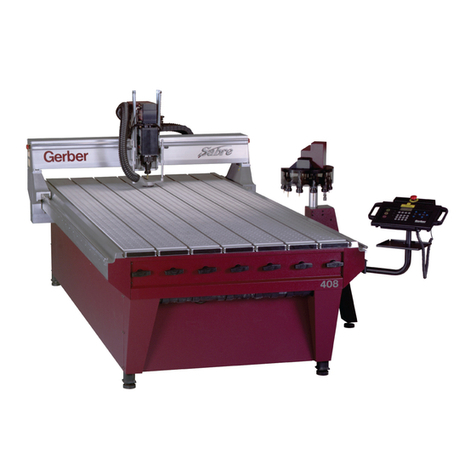
Gerber
Gerber Sabre manual
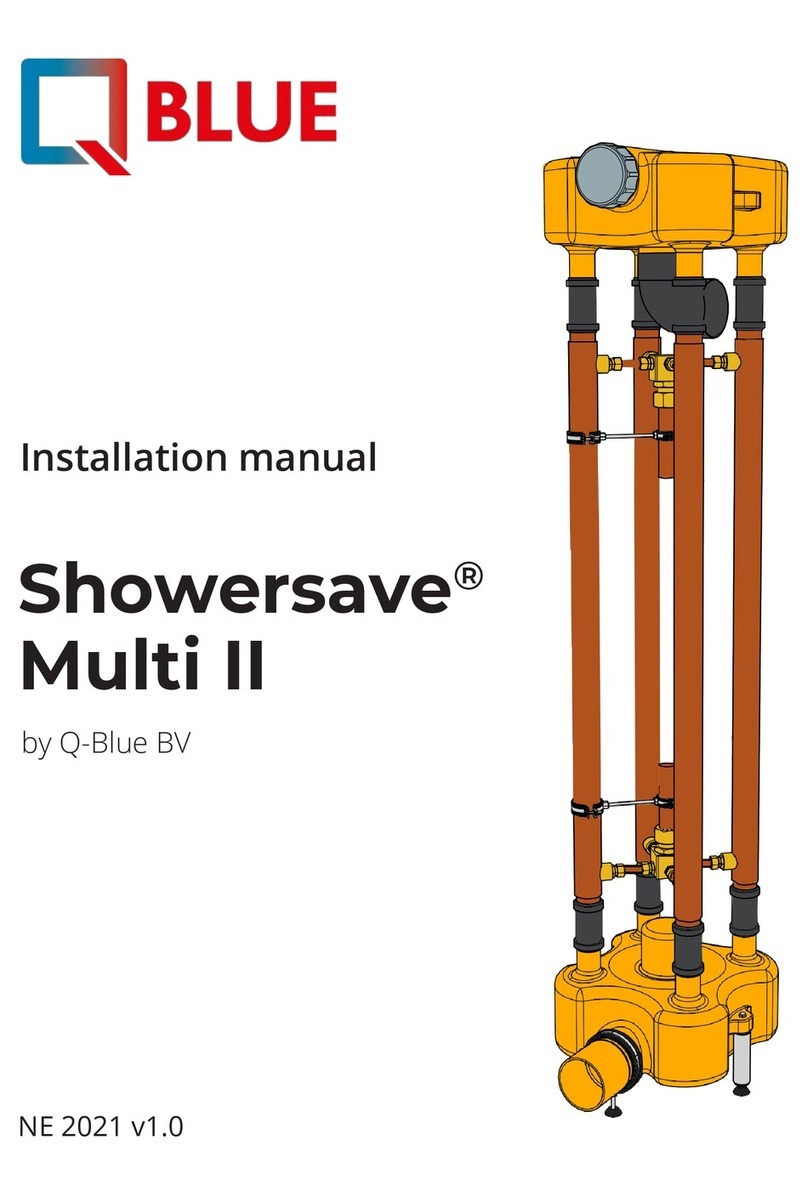
Q-Blue
Q-Blue Showersave Multi II installation manual
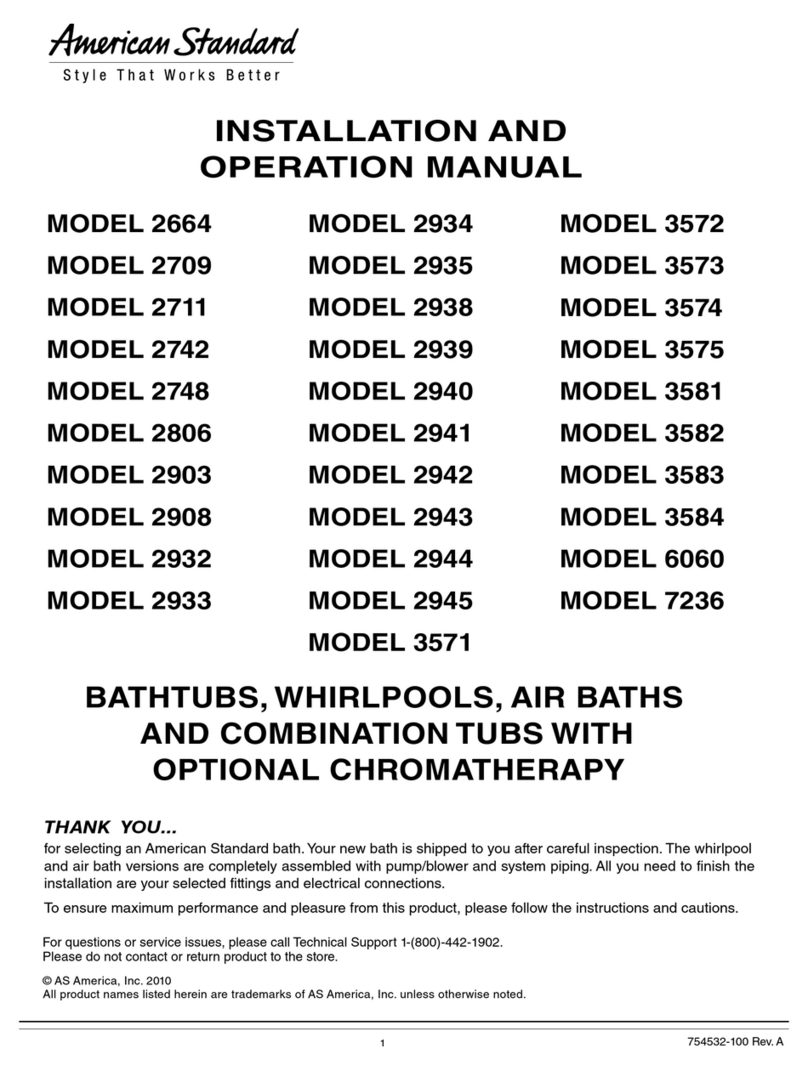
American Standard
American Standard 2664 Installation and operation manual

Olympia
Olympia TUTTO EVO TUT220101 Installation and Maintenance
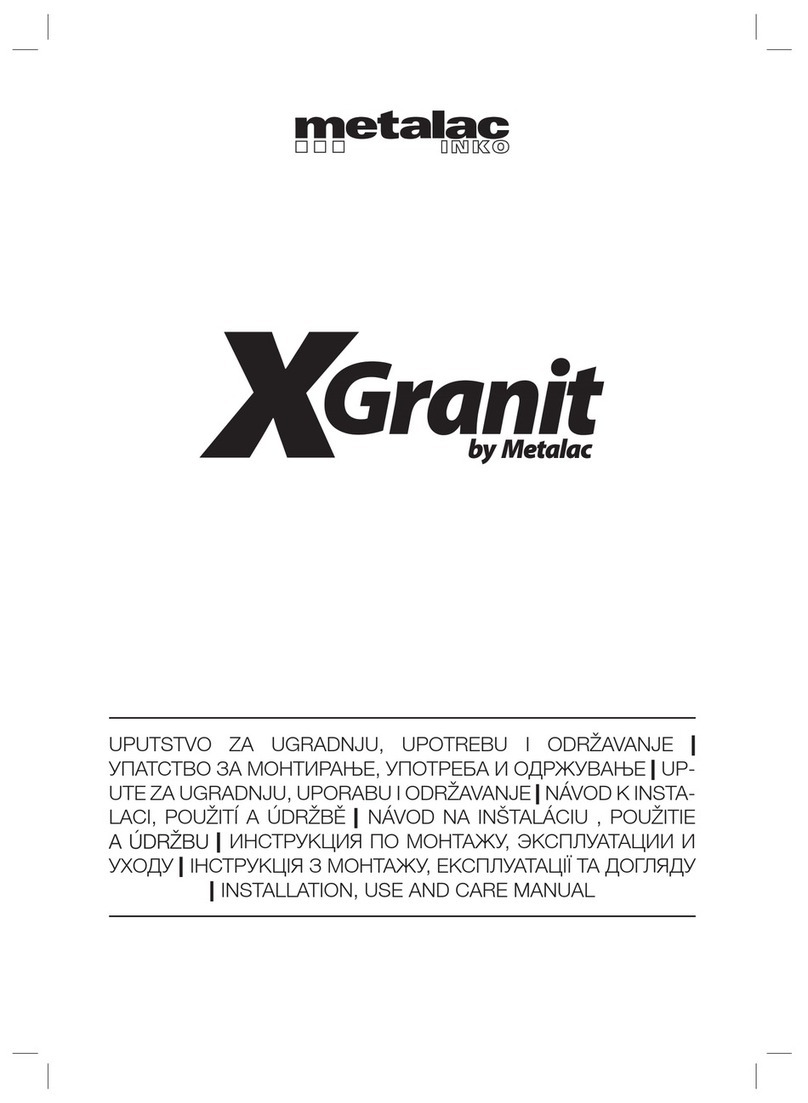
Metalac Inko
Metalac Inko XGranit Installation use and care manual
